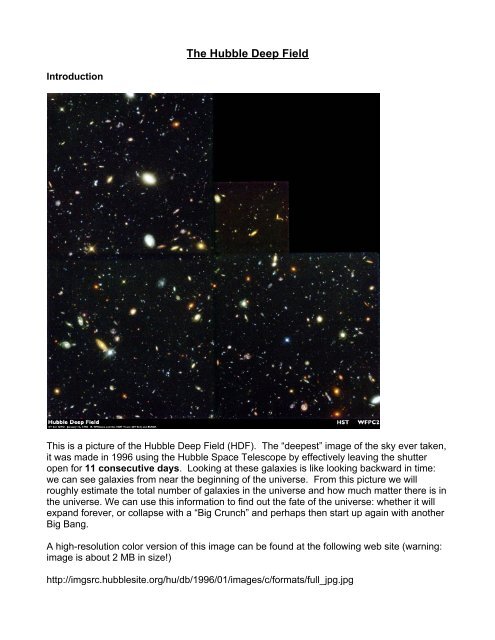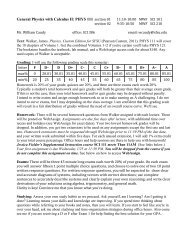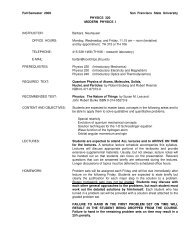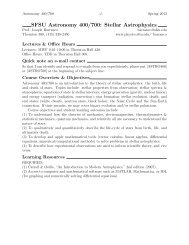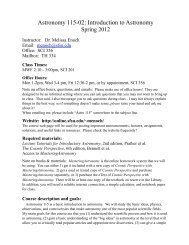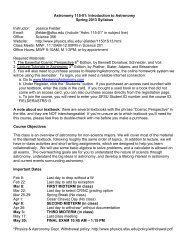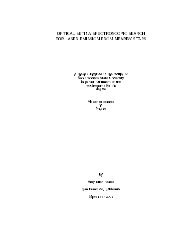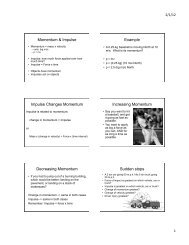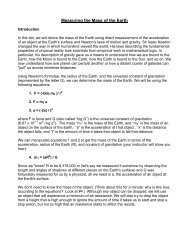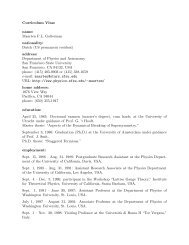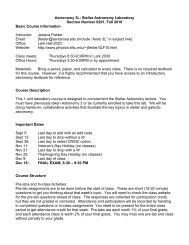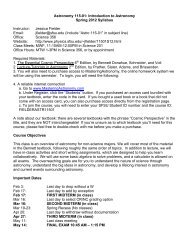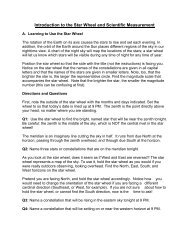Lab for Jul. 14 (The Hubble Deep Field) - SFSU Physics & Astronomy
Lab for Jul. 14 (The Hubble Deep Field) - SFSU Physics & Astronomy
Lab for Jul. 14 (The Hubble Deep Field) - SFSU Physics & Astronomy
You also want an ePaper? Increase the reach of your titles
YUMPU automatically turns print PDFs into web optimized ePapers that Google loves.
<strong>The</strong> <strong>Hubble</strong> <strong>Deep</strong> <strong>Field</strong><br />
Introduction<br />
This is a picture of the <strong>Hubble</strong> <strong>Deep</strong> <strong>Field</strong> (HDF). <strong>The</strong> “deepest” image of the sky ever taken,<br />
it was made in 1996 using the <strong>Hubble</strong> Space Telescope by effectively leaving the shutter<br />
open <strong>for</strong> 11 consecutive days. Looking at these galaxies is like looking backward in time:<br />
we can see galaxies from near the beginning of the universe. From this picture we will<br />
roughly estimate the total number of galaxies in the universe and how much matter there is in<br />
the universe. We can use this in<strong>for</strong>mation to find out the fate of the universe: whether it will<br />
expand <strong>for</strong>ever, or collapse with a “Big Crunch” and perhaps then start up again with another<br />
Big Bang.<br />
A high-resolution color version of this image can be found at the following web site (warning:<br />
image is about 2 MB in size!)<br />
http://imgsrc.hubblesite.org/hu/db/1996/01/images/c/<strong>for</strong>mats/full_jpg.jpg
Part 1: <strong>The</strong> Size of the HDF<br />
First we need to know how big the image is. On Earth, we measure area in square inches,<br />
square feet and square meters, or acres and hectares. In space, we measure distances in<br />
the sky using angle units, like degrees or arc-seconds. We measure area in the sky using<br />
square degrees or square arc-seconds, which we write as (arc-seconds) 2 . <strong>The</strong> area of the<br />
HDF image is equal to the area of a square with 2.4 arc-minute long sides. (<strong>The</strong> actual HDF<br />
image is not square, but L-shaped because it was taken with 4 separate cameras on the<br />
<strong>Hubble</strong>.) One degree contains 60 arc-minutes, and one arc-minute contains 60 arc-seconds.<br />
So the HDF is only looking at a very small portion of the sky (much smaller than, say, the<br />
moon). To help visualize this, we will need to convert from degrees into arcseconds.<br />
<strong>The</strong> area of the moon is: 0.25 (degrees) 2<br />
Q1: Convert the area of the moon into (arc-minutes) 2 (See example on the board)<br />
<strong>The</strong> area of the HDF is: 5.76 (arc-minutes) 2<br />
Q2: How many HDFs can fit into the moon’s area?<br />
Let’s imagine the size of that. Take a sharpened pencil (or pen with a narrow tip) and hold it<br />
at arm’s length. <strong>The</strong> look at the tip of the pencil: the size of that tip is roughly the same area<br />
taken up by the HDF. Now look again at all the galaxies in the HDF. <strong>The</strong>y are all contained<br />
within this pencil-lead sized part of the sky! If there are that many galaxies in that small of an<br />
area, how many galaxies would there be in the whole sky?<br />
Let’s try to estimate that number. First we need to know how many HDFs we would need to<br />
cover the entire sky. <strong>The</strong>n, we need to count the galaxies in the HDF and multiply that by the<br />
number of HDFs in the sky.<br />
<strong>The</strong>re are about 41,000 (degrees) 2 in the entire sky.<br />
Q3: Convert the total area of the sky to (arc-minutes) 2<br />
Q4: How many HDFs would you need to cover the entire sky?<br />
You should be getting a pretty big number. You have just calculated how many “pencil tip”<br />
sized portions there are in the entire sky. Behind every pencil tip held at arm’s length, there<br />
is a field of galaxies containing about as many galaxies as we see in the HDF!
Part 2: <strong>The</strong> Total Number of Galaxies in the Universe<br />
Your next task is to determine the total number of galaxies in the HDF. You could count them<br />
all… but there are easier (and faster) ways to estimate the number. Here a portion of the<br />
HDF is shown that is 1.0 arc-minute long on each side, so it has an area of 1 (arc-minute) 2 .<br />
Q5: Discuss with your partner(s) a plan <strong>for</strong> using this smaller field to estimate the total<br />
number of galaxies in the total HDF, and describe your method on your answer sheet.<br />
Check your method over with the instructor be<strong>for</strong>e you continue.<br />
Q6: Next, determine the number of galaxies in the HDF, using the method your group<br />
outlined in the previous step. We will assume that the HDF is a fairly common patch of sky in<br />
the universe, so we can next use this number combined with our result from Q4 to figure out<br />
how many galaxies there are in the entire universe.
Part 3: <strong>The</strong> Mass and Density of the Universe<br />
(i) <strong>The</strong> Mass of the Universe<br />
Now, let’s estimate the mass of one galaxy, in terms of the mass of the sun (solar units).<br />
We’re going to assume that the Milky Way galaxy, our galaxy, is pretty typical. <strong>The</strong>re are<br />
about 400,000,000,000 (400 billion) stars in the Milky Way. For this exercise, let’s assume<br />
each star has a mass equal to the mass of the Sun, 2 x 10 33 grams.<br />
Q7: Calculate the mass of the Milky Way galaxy in grams, using the in<strong>for</strong>mation in the above<br />
paragraph.<br />
Q8: Now multiply your result from Q7 by the total number of galaxies in the universe to find<br />
the total mass of all galaxies in the universe.<br />
Now we know how much observable matter there is in the universe. We will use this number<br />
to say something about the fate of the universe. For example, is there enough matter in the<br />
universe <strong>for</strong> it to eventually collapse? Another way to ask the question is: Is the gravitational<br />
<strong>for</strong>ce between all the galaxies large enough <strong>for</strong> the universe to eventually pull itself back<br />
together? Well, the gravitational <strong>for</strong>ce depends on the mass AND the distance between the<br />
masses.<br />
(ii) <strong>The</strong> Size of the Universe<br />
We do not know the size of our current universe very accurately, but we can estimate it. We<br />
know that light travels at 3.0 x 10 10 centimeters per second (cm/s). If we assume that the<br />
light from the most distant galaxies was emitted roughly ten billion years ago, we can<br />
calculate the distance.<br />
Q9: How many centimeters are there in one light year? Another way to think about this<br />
question is: how far (in centimeters) can light travel in one year if the speed of light is 3 x 10 10<br />
cm/s?<br />
Q10: <strong>The</strong> farthest galaxies are 10 billion (10,000,000,000) light years away. Express this<br />
distance in centimeters.<br />
(iii) <strong>The</strong> Density of the Universe<br />
<strong>The</strong> <strong>for</strong>mula <strong>for</strong> the volume of a sphere in terms of its radius, r, is: V = (4πr 3 )/3.<br />
Q11: Assuming that the universe is roughly spherical, and its radius is the distance to the<br />
farthest galaxies, calculate the volume of the entire observable universe in units of<br />
centimeters-cubed (cm 3 ).<br />
Q12: Finally, determine the density of the universe in grams per centimeter-cubed (g/cm 3 ).<br />
<strong>The</strong> density is the total mass (which we figured out in Q8) divided by the volume (from Q11).
<strong>The</strong> critical density of the universe is about 5 x 10 -30 g/cm 3 . If the universe is more dense<br />
than this, then the gravitational attraction of all the galaxies will pull the universe together,<br />
reversing the expansion of the universe and creating a so-called “Big Crunch.” Less dense,<br />
and the universe will continue to expand <strong>for</strong>ever.<br />
Q13: Is your observed density of the universe smaller or larger than the critical density?<br />
Based on your calculation, what is the fate of the universe? Will it expand <strong>for</strong>ever or<br />
contract?<br />
Part 4: How reliable is your answer?<br />
We did some sound calculations in this exercise, but we also made several assumptions and<br />
included a range of “educated guesses.” Let’s consider some of our assumptions.<br />
Q<strong>14</strong>: One of our assumptions is that the light collected in the HDF image reveals the<br />
presence of all the mass (in the <strong>for</strong>m of galaxies) within that particular field of view. How<br />
valid is this assumption? Can you think of some types of mass that might not have been<br />
visible in the HDF?<br />
Q15: List at least 3 other assumptions we made in this exercise.<br />
Q16: Discuss how your results would be different if some of the assumptions we made were<br />
not in fact correct. (For example, what if there were large quantities of mass that exist, but<br />
were not detected in the HDF? What would that mean <strong>for</strong> our results?)


